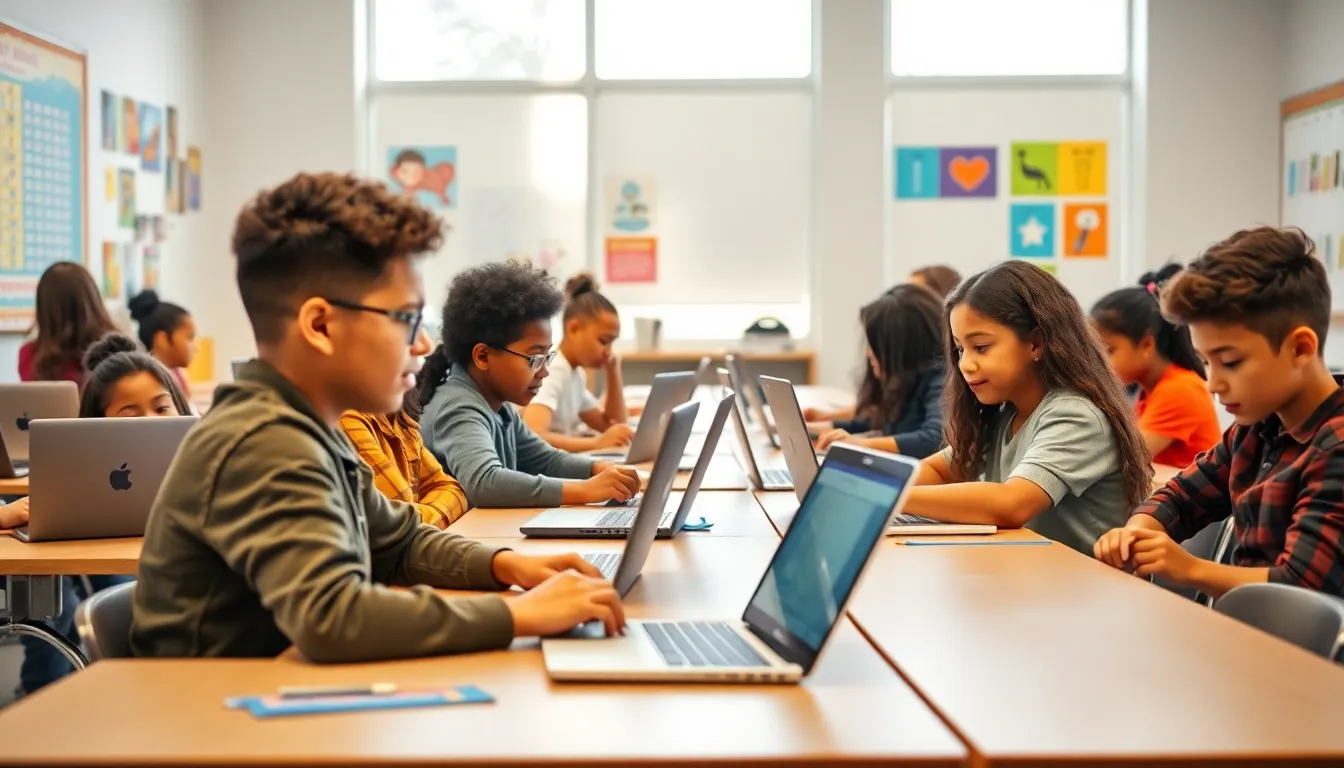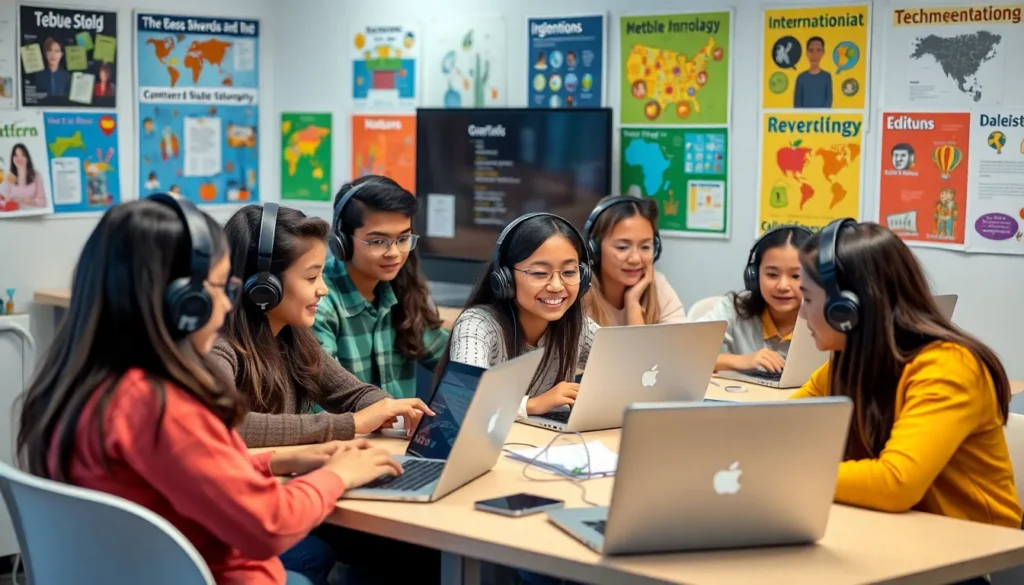Table of Contents
ToggleIn today’s fast-paced digital world, virtual learning environments (VLEs) have transformed the way education is delivered. These platforms offer students and educators the flexibility to engage in learning anytime and anywhere, breaking down traditional classroom barriers. With interactive tools and resources at their fingertips, learners can tailor their educational experiences to fit their unique needs.
As technology continues to evolve, VLEs are becoming increasingly sophisticated, integrating features like gamification and real-time collaboration. This shift not only enhances student engagement but also prepares them for a future where digital skills are paramount. Understanding the benefits and challenges of virtual learning environments is essential for educators and learners alike, paving the way for a more inclusive and effective educational landscape.
Overview of Virtual Learning Environments
Virtual learning environments (VLEs) serve as online platforms that facilitate education through interactive, digital means. These environments enhance learning experiences by incorporating innovative tools and resources.
Definition and Purpose
A virtual learning environment refers to online spaces designed for delivering educational content and fostering interaction among students and educators. VLEs aim to create dynamic and engaging experiences that support varied learning styles. They provide a centralized location for resources, assessments, and communication, promoting a structured approach to education.
Key Features
- User-Friendly Interfaces: Intuitive designs improve navigation and usability for all users.
- Resource Accessibility: Students can access learning materials, such as e-books and videos, from any location.
- Interactive Tools: Features like quizzes, forums, and discussion boards encourage active participation.
- Gamification: Elements like points, badges, and leaderboards increase motivation and engagement.
- Analytics: Monitoring tools track progress and provide insights into student performance.
- Customization: Personalization options allow users to tailor their learning experiences according to their preferences.
- Real-Time Collaboration: Tools like video conferencing and shared documents facilitate communication and group work.
Types of Virtual Learning Environments

Various types of virtual learning environments (VLEs) cater to different educational needs, each with specific functionalities and features.
Learning Management Systems (LMS)
Learning Management Systems (LMS) serve as centralized platforms for creating, delivering, and managing educational courses. These systems facilitate the administration of online courses, allowing educators to upload materials, track student progress, and assess performance efficiently. Examples include Moodle, Canvas, and Blackboard. Key functionalities often include:
- Course Creation: Instructors can develop and organize course materials tailored to their curriculum.
- Assessment Tools: Features like quizzes and assignments evaluate student understanding and provide instant feedback.
- Analytics: Data tracking helps educators monitor student engagement and performance over time.
Virtual Classrooms
- Live Interaction: Teachers can deliver lectures, facilitate discussions, and respond to questions in real time.
- Collaborative Tools: Features such as breakout rooms and shared whiteboards encourage group work and peer interaction.
- Multimedia Integration: Educators can incorporate videos, slides, and other digital resources to enrich the learning experience and engage diverse learning styles.
Advantages of Virtual Learning Environments
Virtual learning environments (VLEs) offer numerous advantages that transform educational experiences. These benefits include flexibility, accessibility, and enhanced collaboration among students and educators.
Flexibility and Accessibility
Flexibility in VLEs allows students to learn at their own pace, accommodating diverse schedules and learning styles. Students access course materials anytime and anywhere, promoting self-directed learning. Accessibility ensures that resources are available to students with disabilities, aligning with inclusive education practices. Platforms provide features like screen readers and captioning, facilitating a supportive environment for all learners.
Enhanced Collaboration
Enhanced collaboration in VLEs fosters interactive and engaging learning experiences. Virtual tools, such as discussion forums and group projects, enable students to work together in real time, regardless of geographical barriers. Educators use collaborative features to facilitate peer feedback and group discussions, promoting critical thinking and communication skills. The ability to collaborate within a digital space prepares students for future workplaces that increasingly rely on teamwork and remote interactions.
Challenges and Limitations
Virtual learning environments (VLEs) present several challenges and limitations that impact their effectiveness in education.
Technical Issues
Technical issues frequently disrupt virtual learning experiences. Connectivity problems can prevent students from accessing course materials or participating in live classes. Device compatibility problems may further complicate the use of VLEs, as not all students have access to the necessary technology. Additionally, software glitches can hinder the functionality of interactive tools, diminishing the overall user experience. Institutions must prioritize robust IT support to resolve these technical challenges swiftly.
Engagement and Interaction
Engagement and interaction often suffer in a virtual setting compared to traditional classrooms. The lack of in-person connections can lead to feelings of isolation among students. Some learners may struggle with motivation and find it challenging to remain engaged during online lectures. Interactive features, while beneficial, may not fully replicate the dynamic of face-to-face discussions. It’s essential for educators to incorporate diverse strategies to foster interaction, such as breakout rooms and collaborative projects, to effectively engage students in virtual environments.
Future Trends in Virtual Learning Environments
Virtual learning environments continue to evolve, integrating advanced technologies and adaptive educational practices. The future of VLEs promises enhanced interactivity, personalization, and engagement for learners.
Emerging Technologies
Emerging technologies significantly influence the landscape of virtual learning environments.
- Artificial Intelligence (AI): AI personalizes learning experiences by analyzing student data and adapting content to meet individual needs.
- Virtual Reality (VR): VR creates immersive educational experiences that simulate real-world situations, enhancing understanding through experiential learning.
- Augmented Reality (AR): AR overlays digital information in the physical world, providing interactive content that enriches learning materials.
- Blockchain: Blockchain technology offers secure certification and transcript management, ensuring the authenticity of academic records.
These technologies reshape VLEs, making them more interactive and engaging while fostering collaboration and critical thinking skills.
Evolving Educational Practices
Evolving educational practices contribute to the effectiveness of virtual learning environments.
- Flipped Classrooms: This approach encourages students to engage with instructional content at home and participate in hands-on activities during virtual class sessions.
- Personalized Learning Paths: Customizable learning experiences allow students to progress according to their unique strengths and interests, increasing motivation and retention.
- Project-Based Learning: Emphasizing real-world applications, project-based learning encourages teamwork and problem-solving, preparing students for future challenges.
- Continuous Assessment: Frequent assessments and feedback enhance learning while ensuring students stay aligned with learning objectives.
These practices promote an adaptive approach to education, accommodating diverse learner needs and preparing students for an increasingly complex world.
Virtual learning environments are transforming education by offering flexibility and accessibility that traditional classrooms often can’t match. As these platforms evolve with advanced technologies and innovative teaching methods, they create engaging experiences tailored to individual learning styles.
While challenges exist, such as technical issues and potential feelings of isolation, the benefits of VLEs far outweigh the drawbacks. By fostering collaboration and enhancing critical skills, they prepare students for a future that increasingly values digital proficiency.
As educators continue to adapt and refine their approaches, the potential for VLEs to revolutionize learning remains significant, paving the way for a more inclusive and effective educational landscape.







